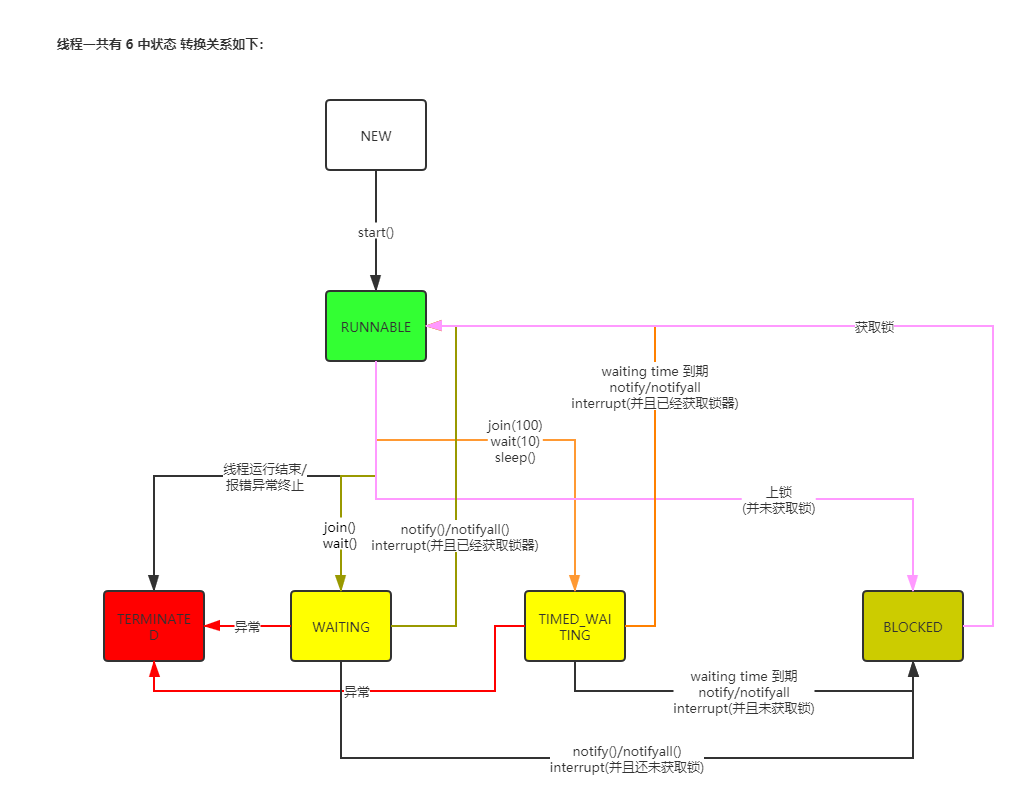线程-Thread类源码解析及线程状态分析
1、常用方法 源码解析
2、 线程状态详细分析
构造函数源码解析:
Thread类对外开放的 public 构造
public Thread() {
this((ThreadGroup)null, (Runnable)null, "Thread-" + nextThreadNum(), 0L);
}
public Thread(Runnable target) {
this((ThreadGroup)null, target, "Thread-" + nextThreadNum(), 0L);
}
Thread(Runnable target, AccessControlContext acc) {
this((ThreadGroup)null, target, "Thread-" + nextThreadNum(), 0L, acc, false);
}
public Thread(ThreadGroup group, Runnable target) {
this(group, target, "Thread-" + nextThreadNum(), 0L);
}
public Thread(String name) {
this((ThreadGroup)null, (Runnable)null, name, 0L);
}
public Thread(ThreadGroup group, String name) {
this(group, (Runnable)null, name, 0L);
}
public Thread(Runnable target, String name) {
this((ThreadGroup)null, target, name, 0L);
}
public Thread(ThreadGroup group, Runnable target, String name) {
this(group, target, name, 0L);
}
public Thread(ThreadGroup group, Runnable target, String name, long stackSize) {
this(group, target, name, stackSize, (AccessControlContext)null, true);
}
/**
* @param g 指定此线程属于线程组
* @param target runnable 对象
* @param name 线程名
* @param stackSize 最大线程栈 大小
* @param inheritThreadLocals 是否继承 父线程的 threadlocal 属性值
*/
public Thread(ThreadGroup group, Runnable target, String name, long stackSize, boolean inheritThreadLocals) {
this(group, target, name, stackSize, (AccessControlContext)null, inheritThreadLocals);
}
私有 构造
/**
* @param g 指定此线程属于线程组
* @param target runnable 对象
* @param name 线程名
* @param stackSize 最大线程栈 大小
* @param acc
* @param inheritThreadLocals
*/
private Thread(ThreadGroup g, Runnable target, String name, long stackSize, AccessControlContext acc, boolean inheritThreadLocals) {
this.daemon = false;
this.stillborn = false;
this.threadLocals = null;
this.inheritableThreadLocals = null;
this.blockerLock = new Object();
// 所有的线程必须有名字
if (name == null) {
throw new NullPointerException("name cannot be null");
} else {
this.name = name;
Thread parent = currentThread();
SecurityManager security = System.getSecurityManager();
if (g == null) {
// 如果线程组为 null
// 1 首先从 当前安全管理器中 获取 线程组
if (security != null) {
g = security.getThreadGroup();
}
// 2 如果 仍没有 线程组
// 从 当前线程(很大可能 mian 线程) 获取 线程组
if (g == null) {
g = parent.getThreadGroup();
}
}
// 线程组校验
g.checkAccess();
if (security != null && isCCLOverridden(this.getClass())) {
security.checkPermission(SecurityConstants.SUBCLASS_IMPLEMENTATION_PERMISSION);
}
// 线程组 添加未开始的 线程数
g.addUnstarted();
this.group = g;
// 线程是否是守护线程 和 优先级 都有继承性
this.daemon = parent.isDaemon();
this.priority = parent.getPriority();
if (security != null && !isCCLOverridden(parent.getClass())) {
this.contextClassLoader = parent.contextClassLoader;
} else {
this.contextClassLoader = parent.getContextClassLoader();
}
this.inheritedAccessControlContext = acc != null ? acc : AccessController.getContext();
this.target = target;
this.setPriority(this.priority);
if (inheritThreadLocals && parent.inheritableThreadLocals != null) {
//InheritableThreadLocal主要用于子线程创建时,自动继承父线程的ThreadLocal变量,方便必要信息的进一步传递。
this.inheritableThreadLocals = ThreadLocal.createInheritedMap(parent.inheritableThreadLocals);
}
this.stackSize = stackSize;
this.tid = nextThreadID();
}
}
线程默认名称
private static int threadInitNumber;
private static synchronized int nextThreadNum() {
return threadInitNumber++;
}
线程状态
/** Thread 类 内部 枚举
* 线程状态一共有 6 种
*/
public static enum State {
NEW,
RUNNABLE,
BLOCKED,
WAITING,
TIMED_WAITING,
TERMINATED;
private State() {
}
}
线程状态图

线程实例方法源码解析
start()
/**
*/
public synchronized void start() {
if (this.threadStatus != 0) {
throw new IllegalThreadStateException();
} else {
// 往线程组中添加 该线程
this.group.add(this);
boolean started = false;
try {
// 线程开始 是 native 方法
this.start0();
started = true;
} finally {
try {
// 如果 线程启动失败 从 该 线程组中 remove 掉 此线程
if (!started) {
this.group.threadStartFailed(this);
}
} catch (Throwable var8) {
}
}
}
}
private native void start0();
run()
/**
*/
public void run() {
// 直接调用 runnable 中的 run() 方法体的逻辑
if (this.target != null) {
this.target.run();
}
}
interrupt()
/**
* 添加 中断标识
* interrupt() 方法只是改变中断状态而已,它不会中断一个正在运行的线程
* 如果线程被Object.wait, Thread.join和Thread.sleep三种方法之一阻塞,此时调用该线程的interrupt()方
* 法,那么该线程将抛出一个 InterruptedException中断异常(该线程必须事先预备好处理此异常)从而提早地终结
* 被阻塞状态
*/
public void interrupt() {
if (this != currentThread()) {
// 校验 你是否有权限 线程修改
this.checkAccess();
synchronized(this.blockerLock) {
Interruptible b = this.blocker;
if (b != null) {
this.interrupt0();
b.interrupt(this);
return;
}
}
}
this.interrupt0();
}
setPriority(int newPriority)
/**
* 设置线程优先级
* newPriority 越大 优先级越高
*/
public final void setPriority(int newPriority) {
// 校验 你是否有权限 线程修改
this.checkAccess();
// 线程优先级 区间[1,10]
if (newPriority <= 10 && newPriority >= 1) {
ThreadGroup g;
if ((g = this.getThreadGroup()) != null) {
// 调整 线程优先级 最大 不超过 所在线程组的最大值(默认10 可能小于10)
if (newPriority > g.getMaxPriority()) {
newPriority = g.getMaxPriority();
}
this.setPriority0(this.priority = newPriority);
}
} else {
throw new IllegalArgumentException();
}
}
getPriority()
/**
* 获取线程优先级
**/
public final int getPriority() {
return this.priority;
}
join()
/**
* 让线程进入 waiting 状态
* 如果 millis == 0L 线程进入 waiting
* 如果 millis > 0L 线程进入 timed waiting
**/
public final synchronized void join(long millis) throws InterruptedException {
long base = System.currentTimeMillis();
long now = 0L;
if (millis < 0L) {
throw new IllegalArgumentException("timeout value is negative");
} else {
if (millis == 0L) {
while(this.isAlive()) {
this.wait(0L);
}
} else {
while(this.isAlive()) {
long delay = millis - now;
if (delay <= 0L) {
break;
}
// 使用wait 方法 所以 会 释放 cpu占用
this.wait(delay);
now = System.currentTimeMillis() - base;
}
}
}
}
public final synchronized void join(long millis, int nanos) throws InterruptedException {
if (millis < 0L) {
throw new IllegalArgumentException("timeout value is negative");
} else if (nanos >= 0 && nanos <= 999999) {
if (nanos >= 500000 || nanos != 0 && millis == 0L) {
++millis;
}
this.join(millis);
} else {
throw new IllegalArgumentException("nanosecond timeout value out of range");
}
}
public final void join() throws InterruptedException {
this.join(0L);
}
线程static方法
sleep(long var0)
// 线程 进入 waitting timed 状态
// 不会释放cpu 资源(这是和 wait 和 join 很大 区别)
public static native void sleep(long var0) throws InterruptedException;
public static void sleep(long millis, int nanos) throws InterruptedException {
if (millis < 0L) {
throw new IllegalArgumentException("timeout value is negative");
} else if (nanos >= 0 && nanos <= 999999) {
if (nanos >= 500000 || nanos != 0 && millis == 0L) {
++millis;
}
sleep(millis);
} else {
throw new IllegalArgumentException("nanosecond timeout value out of range");
}
}
yield()
/**
* Java线程中的Thread.yield( )方法,译为线程让步。顾名思义,就是说当一个线程使用了这个方法之后,它就会把自* 己CPU执行的时间让掉,让自己或者其它的线程运行,注意是让自己或者其他线程运行,并不是单纯的让给其他线程
*
* example 小朋友们 一起抢一个球 现在被我抢到了,我突然大喊“我把球重新丢出去,谁先抢到是谁的”(注意是我
* 们,包含自己),然后大家重新进入抢球大战
* 与wait 区别是 wait 让出 cpu资源 自己不在加入 抢资源的 大军
*/
public static native void yield();
!
NOTE: 一起学习交流,如有不正确的地方请大家指正,虚心接受更正
